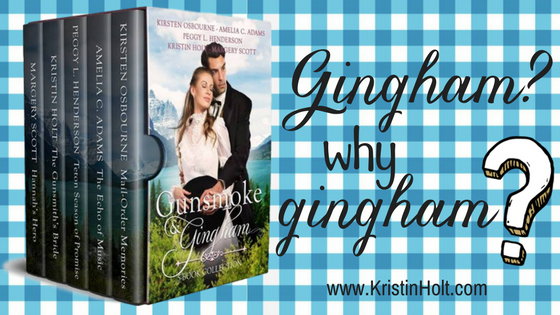
by Kristin Holt | Mar 2, 2017 | Articles
In the 19th century American West, Gingham was more than checked fabric made of cotton–it was also striped. Any woven cotton cloth made of pre-dyed alternating threads (plaid, striped, or checked) was called gingham. Why would pioneers (or frontiersman, or Old West women) select gingham? What made this fabric practical? Why would we name an anthology with Gingham in the title?

by Kristin Holt | Nov 19, 2016 | Articles
Were earrings popular and common within the nineteenth century? Or did they come into vogue (and acceptance) post 1900?
This article references period newspapers, catalogs, and vintage photographs. Also discloses an element of cover art for (Gus’s Story) The Marshal’s Surrender.

by Kristin Holt | Oct 26, 2016 | Articles
While dimples and beauty marks were seen as attractive and stylish, Victorian Americans deplored freckles, “moth marks”, suntans, and sunburns–most unfeminine! Commercial products promised to eradicate such unwelcome blemishes and guaranteed beauty! If potions and powders failed, one photographer promised no freckles showed in his cabinet cards.

by Kristin Holt | Oct 17, 2016 | Articles
While bath tubs of various styles were available in cities by the mid-nineteenth century, the American Old West didn’t have easy access to delivery of such finery until after the Transcontinental Railway in 1869 (followed by additional railroads bringing delivery nearer to home) eliminated freight by horse-drawn wagon. Historic images of Montgomery Ward & Co. catalogs and Sears, Roebuck & Co. catalogs illustrate available options–some of which are simply too ingenious to miss! Who knew a kitchen sink so easily doubled as a bath tub? Or that a five-and-a-half-foot bathtub could fold up? Price comparisons (then to now) show why it took a good long while for most folks to afford more than a public bath (next post) or a bowl and pitcher to make do.

by Kristin Holt | Oct 2, 2016 | Articles
The Old West Barber Shop Blog Series continues. This article includes images of historic barber chairs, an antique towel steamer (and hot water dispenser), line art of the era illustrating the pedestal used in lieu of a barber’s chair, images from mail-order catalogues showing tools of the trade available for home purchase, and patents for barber chairs and devices. This series’ upcoming posts will detail Victorian-era men’s hairstyles, bath houses, bath tubs, shower baths, ingenious furniture-bath-tub combinations, and ladies’ hair salons.













